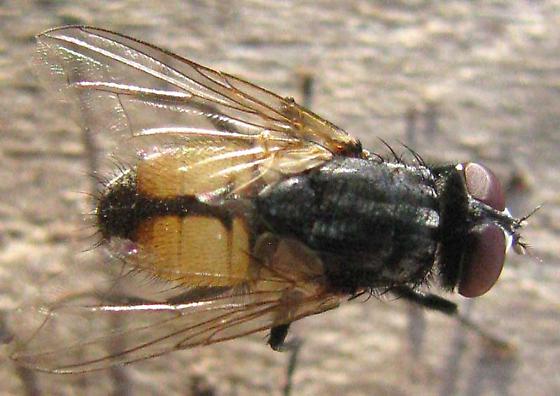Excerpts from Jim Conrad's
Naturalist Newsletter

from the October 28, 2012 Newsletter issued from the valley of the Dry Frio River in northern Uvalde County, southwestern Texas, on the southern border of the Edwards Plateau; elevation ~1750m (~5750 ft); N29.62°, W99.86°; USA
FACE FLIES
Our neighbor lets her critters run loose so Minnie the Cow spends a lot of time on the cabin's grassy area grazing and depositing big, soft blobs of poop. I transfer the poop to a bucket of water, for making "manure tea," which keeps my favorite plants green and robust.
However, just the greasy places left where the poop falls draw flies, and Minnie's broad sides usually are splotched with great, dark gatherings of flies by the thousands. When we sit outside for our meals, the flies buzz all about so naturally one wonders whether they are regular House Flies or something else, since they're from Minnie and not the house. I photographed one of Minnie's flies perched beside my dinner plate, and that's the picture above.
In fly identification, wing venation is very important. Volunteer identifier Bea in Ontario didn't have fly venation diagrams, so she posted our picture at BugGuide.net. In just a couple of hours John Carr, a software specialist at MIT in Massachusetts but whose hobby is bugs, had labeled it: Face Fly, also called Autumn House-Fly, MUSCA AUTUMNALIS. It's the same genus as the House Fly but a different species. It's widespread throughout most of Europe, Central Asia, also northern India, Pakistan, China, and some parts of North Africa, and was introduced into North America around the 1940s. Now it's spread through most of the US and into southern Canada.
Face Flies feed on the juices in manure, and plant sugars. On cattle and horses they feed on secretions around the eyes, mouth and nostrils, plus they feed on blood oozing from wounds such as Horse-fly bites. Most flies pestering a cow will be females because they're the ones needing most the protein in the cow's juices and blood. During the night they rest on vegetation. Face Flies do spread diseases among animals, such as eyeworm and pinkeye.
As we have our meals outside each day, we'll be checking on whether they're all the same species.